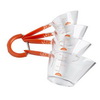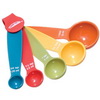|
Cooking Measuring Tools – Creating Perfectly Balanced IngredientsCooking measuring tools assist in adding the perfect blend of ingredients to a recipe. The reason that some fail in their cooking attempts because they don’t realize that a recipe is actually a scientifically balanced combination of ingredients, and that putting a pinch of this and a dash of that is really a myth unless of course you know what a pinch or a dash is really equivalent to in measurement terms and that a pinch or a dash is the same all of the time, it’s a consistent measurement.
In order to be a reasonably competent cook you can’t really just put in what you feel will work, the right ingredients mixing with the other ingredients in a recipe really do have to be balanced. So, just what are some of the cooking measuring tools that help to achieve that perfectly balanced recipe? The most common measuring tools for cooking are measuring cups of two different types and measuring spoons.
Measuring Cups The two different types of measuring cups are used for different types of measure, one is for liquid measurements and one is for dry measurements and the two aren’t interchangeable. The liquid measuring cup is generally made of clear glass or plastic with different intervals of measure visible on the cup and a pouring spout, and in sizes of 1 cup, 2 cups, 4 cups and 8 cups. The dry measuring cup generally is made of stainless steel or plastic, has a handle and comes in sets with sizes of ¼ cup, 1/3 cup, ½ cup and 1 cup, with other sizes in some sets such as 1/8 cup or 2/3 cup.
Liquid measuring cups are used for such liquids as milk, oil, water, corn syrup, honey and molasses. The dry measuring cups are used for such measurements as sugar, flour, and corn meal. Dry measuring cups are generally leveled with a long flat object such as a knife or spatula to give the precise measurement that results in the exact ingredient needed in a recipe.
The cup is the common unit of measurement of volume. Measuring Spoons Measuring spoons come in what are called nested sets, meaning one spoon fits inside of the next largest size spoon. These sets come in stainless steel and plastic, although plastic is a good strong material, stainless steel spoons are the most durable and the easiest to keep sanitary, and stainless steel unlike plastic doesn’t carry over the taste of the plastic into the food as has been the case with plastic bowls (but that’s a story for another time). Measuring spoons generally come in measurements of 1/8 teaspoon, ¼ teaspoon, ½ teaspoon, 1 teaspoon, and 1 tablespoon.
• The Taste of Home Cookbook – All New Edition from Taste of Home Books, Reiman Media Group • The All New Good Housekeeping Cook Book, Edited by Susan Westmoreland, Hearst Books, New York
Cooking Measuring Techniques
|


















